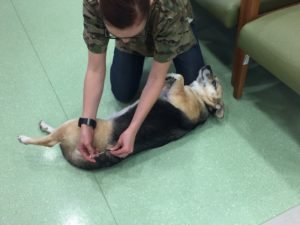
By Stuttgart Veterinary Treatment Facility
It’s PCS season, and one of the most common phone calls the vet clinic receives during this time of year is from folks who are getting ready to return to the U.S. and want to know how to take their pet with them.
 As with anything else during a move from one duty station to the next, there are many factors involved and paperwork and planning is everything. Factors that can influence what procedures you need to follow include: species, breed, and age of your pet, your final destination, and on which airline your pet will be traveling on. Taking the time to learn the regulations and your options can make your animal’s move less stressful for everyone.
As with anything else during a move from one duty station to the next, there are many factors involved and paperwork and planning is everything. Factors that can influence what procedures you need to follow include: species, breed, and age of your pet, your final destination, and on which airline your pet will be traveling on. Taking the time to learn the regulations and your options can make your animal’s move less stressful for everyone.
First of all, a couple words of advice based off FAQs and/or frequently encountered mistakes:
- DO NOT wait until you receive orders to look into the requirements of your destination country. Some countries (such as, Japan) may take several months of advance planning.
- DO NOT let your pet’s medical records (such as their original rabies certificates) get packed up with your HHGs
- DO NOT let your pet’s rabies vaccine expire
- Health certificates CAN also be done at host nation clinics
- Rabies vaccines that are documented appropriately in your pet’s European Pet Passport (must be the blue official pet passport) DO count as an original and official proof of rabies vaccination. Receipts from hospitals, photocopies of an original rabies certificate, or other unofficial pet passports DO NOT count as an official proof of rabies vaccination.

Are you returning to the United States? The Centers for Disease Control and Prevention governs the import of dogs and cats into the U.S. However, states and territories often have additional requirements as do certain airlines. In general, dogs and cats are required to have a current rabies vaccine that is at least 30 days old, not be ill with an infectious and/or zoonotic disease, be examined by a veterinarian, and have a health certificate signed within ten days of arrival in the U.S. Are you thinking about taking an animal other than a dog or cat back to the U.S.? Specific regulations depend on the species. The U.S. Department of Agriculture governs the importation of birds, horses, rabbits, and other small mammals while the U.S. Fish and Wildlife Service sets regulations for importing reptiles and fish and the CDC oversee the importation of turtles.

What about Hawaii and Guam? For dogs and cats traveling to these rabies-free locations, there are many additional regulations that apply so it is best to do some research online. Hawaii’s process can take more than four months to complete. Skipping steps can lead to heavy fines and your pet being quarantined for up to 120 days at your expense.
What if your next duty station is not in the United States? Japan and South Korea are two common destinations for families associated with the military. Japan’s process involves very specific paperwork and can take up to eight months to complete. South Korea has similar requirements and mandates that a German federal veterinarian sign your pet’s paperwork.
 When making flight arrangements, consider the following: Each airline has its own rules when traveling with an animal, so you must research them to make sure your pet will be accepted. Some airlines don’t allow pets in the cabin on transatlantic flights. Others will not accept brachycephalic or “snub-nosed” dogs and cats as checked luggage. Many airlines also restrict transporting animals when the forecasted temperature is too high or low at any location on your itinerary. Shipping your pet unaccompanied as cargo instead of luggage can help ease these restrictions.
When making flight arrangements, consider the following: Each airline has its own rules when traveling with an animal, so you must research them to make sure your pet will be accepted. Some airlines don’t allow pets in the cabin on transatlantic flights. Others will not accept brachycephalic or “snub-nosed” dogs and cats as checked luggage. Many airlines also restrict transporting animals when the forecasted temperature is too high or low at any location on your itinerary. Shipping your pet unaccompanied as cargo instead of luggage can help ease these restrictions.
Another option for military members is flying Space A out of Ramstein Air Base using the Air Force’s Air Mobility Command. DoD has reserved pet shipments for passengers in PCS status. Service animals may fly with a member with proper /documentation. Only service animals may accompany military members on Space A who are on PCS orders. You will need to contact the Ramstein passenger terminal for details on how to get your animal a spot on the plane. Be sure to make follow-on arrangements to get to your final destination.
Whatever travel arrangements you choose, you should set aside some cash for the airline fees. They can sometimes exceed a few hundred dollars.
Your pet has been with you during this exciting time in Europe. Getting them to your next adventure requires some planning and flexibility but many people and pets have gone before and been happy when it is over. So, start early, research and discuss your options with your family, choose what works best for you and your pet, and let your veterinarian know if you need help.
- Reserve air space for shipment as early as possible.
- Do a cost comparison of shipping your pet as excess baggage versus air freight shipment, if applicable.
- Provide a sturdy leak-proof crate (lined with absorbent material such as newspaper) that is large enough for the animal to stand, lie down, or turn around in, but not so large that the animal would be battered around in rough weather.
- Let your pet become accustomed to the crate before shipment by having practice sessions that build in time of confinement. Be sure the pet has a comfortable pad to lie on and a few familiar toys. A leash should also be included with the crate.
- Put identification tags that include an emergency phone number around your pet’s neck.
- Print your name and destination address clearly on the shipping crate. Include your pet’s name, so that attendants can talk with him/her. If the pet has special habits — or bites —also include that information.
- Carry a photo of your pet with you.
- Feed your pet just a light meal about six hours before shipping — no water within two hours unless it is very hot (or the animal is very small). A water dish that is attached so it cannot tip should be provided, but it should be conveniently located to allow an attendant to provide water at stopovers without being bitten.
- Send dry food along if the trip is long.
- Do not tranquilize the animal.
- Exercise your pet just before shipping so your animal will sleep better during the trip.
- Check with the agent who meets the flight about your pet’s progress when you are changing planes.
- Allow plenty of time between connecting flights to be sure your animal is transferred to your flight if traveling with you.
- Arrange to have your pet picked up immediately upon arrival. Airline facilities for pets may be limited or nonexistent.
Contacting the vet clinic
The Stuttgart Veterinary Treatment Facility is located in Bldg. 2996A, adjacent to the Dental Clinic, on Panzer Kaserne. The phone numbers are 590-1888 or 0637-9464-1888. You can also find them on Facebook.
(Editor’s note: This is an updated version of an article that ran in previous editions of the PCS-out special edition of the Citizen.)

